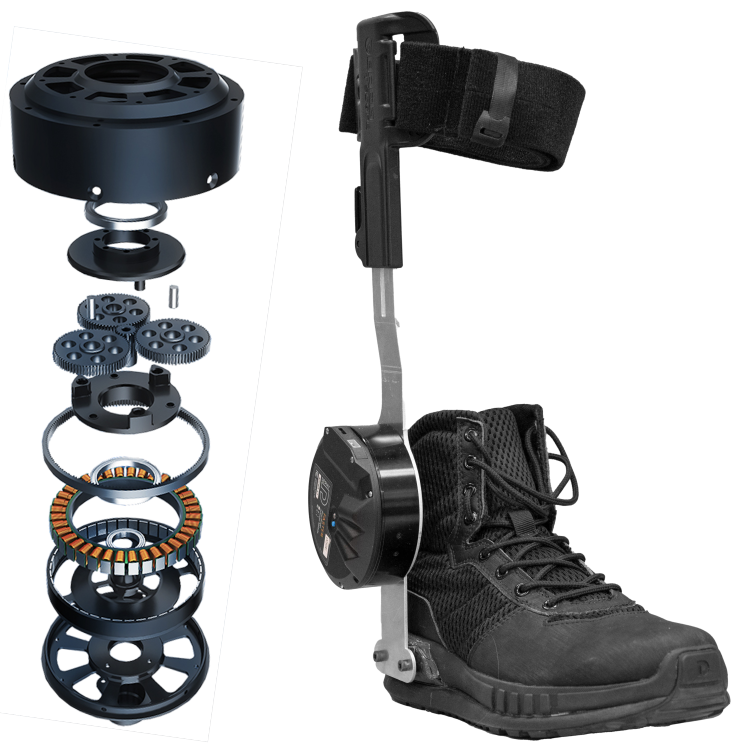Estimates indicate that by 2050 the U.S. will incur a two-fold increase in the incidence of amputation and stroke, due largely to the prevalence of vascular disease. These disabilities severely limit mobility and social activity for millions of Americans, whose ambulation is slower, less stable, and less efficient than that of able-bodied persons. The projected increase in mobility-related disabilities therefore presents a grand challenge to the American workforce and healthcare system. This motivates our research on high-performance wearable robots to enable mobility and improve quality of life for persons with disabilities.
Phase-Based Control of Prosthetic Legs
Even with the help of modern prosthetic devices, individuals with lower-limb amputation often struggle to walk in the home and community. Emerging powered prosthetic legs have motors that can actively assist patients to enable greater mobility, but these devices are currently designed to produce a small set of pre-defined motions. Finite state machines are typically used to switch controllers between discrete phases of the gait cycle, e.g., heel contact vs. toe contact, and between different tasks, e.g., uphill vs. downhill. However, this discrete methodology cannot continuously synchronize the prosthetic leg's motion to the timing or activity of the human user, and its complexity presents significant challenges with mode classification and patient-specific tuning. We are investigating a continuous parameterization of human joint patterns based on 1) a phase variable that robustly represents the timing of the human gait cycle, and 2) task variables representing continuous variations of steady-state activities (e.g., walking at different speeds/inclines) or continuous transitions between activities (e.g., walk to stair ascent). The resulting user-synchronized control methodologies will enable greater mobility in amputee populations and beyond.
Key Papers: JNER 2025, TRO 2025, TRO 2023, TRO 2018, TNSRE 2017
This material is based upon work supported by the National Institutes of Health under Grant Numbers DP2HD080349 and R01HD094772 and by the National Science Foundation under Grant Numbers 1949346 and 2024237.
Task-Agnostic, Energetic Control of Exoskeletons
Mobility challenges are ubiquitous in both healthy individuals working in physically demanding jobs and impaired individuals navigating the home and community. Robotic lower-limb exoskeletons (i.e., powered orthoses) have great potential to assist both impaired and unimpaired users in the home, community, and workplace, but critical barriers in exoskeleton design and control continue to limit their use cases. Traditional control methodologies for rehabilitation exoskeletons impose normative joint kinematic patterns on severely impaired users. Transitions between discrete tasks must be automatically classified (with inevitable errors) or manually triggered by the user or therapist. This task-specific paradigm also does not allow the continuous range of activities encountered in everyday life. Similarly, emerging partial assistance exoskeletons follow task-specific, time-based torque profiles that restrict users to a small set of pre-defined activities. A paradigm shift from task-specific to task-agnostic control approaches is needed for wearable robots to seamlessly assist their human users across activities of daily life. We are investigating a novel task-agnostic control methodology that shapes the energetic dynamics of the human body with wearable actuators. For example, this paradigm can dynamically reduce mass/inertia parameters in body energetics to offload the weight of a stroke patient during gait rehabilitation. Data-driven energy-shaping approaches provide a fraction of biological torque to reduce muscle effort and joint loads that contribute to fatigue or arthritic pain. This innovation in control will enable exoskeletons to assist humans in a variety of activities, which cannot be achieved with available commercial devices.

Key Papers: SciRob 2024, TCST 2024, OJCSYS 2022, CSM 2018
This material is based upon work supported by the National Science Foundation under Grant Number 1652514 / 1949869 and by the National Institutes of Health under Grant Number R01EB031166.

Wearable Actuator Design for High-Performance Torque Control
Actuators for lower-limb orthoses/prostheses must balance the requirements of high output torque and low weight, which has been achieved using small (high-speed) motors with high-ratio transmissions. However, high-ratio transmissions result in high mechanical impedance (e.g., friction/inertia), which means that the user cannot move (or "backdrive") the joint without help from the actuator. Users with partial or full control of their legs require exoskeletons with backdrivable actuators to facilitate voluntary motion and comfort. Robotic prosthetic legs also need backdrivability to swing freely and absorb forceful impacts for more natural amputee gaits. Inspired by emerging legged robot designs, we are designing compact, lightweight, wearable actuators using custom high-torque motors with custom low-ratio transmissions (24:1 or less) to achieve high output torques with very low mechanical impedance. Compared to conventional actuators, this class of "quasi-direct drive" actuators is quieter, more energy efficient, and better at controlling torque/impedance (without a load cell). We have deployed these actuators on multiple generations of lower-limb exoskeletons and prosthetic legs, and we have released open-source designs for our modular hip, knee, and/or ankle exoskeleton, M-BLUE.
Key Papers: RAL 2022, TMECH 2021, TRO 2020
This material is based upon work supported by the National Institutes of Health under Grant Numbers DP2HD080349, R01HD094772, and R01EB031166.
Optimal Design of Robust Compliant Actuators
The major goal of this project is to establish a robust convex optimization framework for the design of series elastic actuators that are energy-efficient and safe across a wide variety of situations. Visit this Project Webpage.


